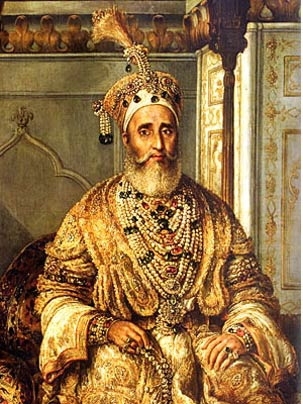Despite the vacation-week lull, more than 125 students, faculty and visitors came to hear renowned travel writer and historian William Dalrymple discuss his latest book. "The Last Mughal: The Fall of a Dynasty, Delhi, 1857" (Knopf, $30) is a dynamic narrative of the final flowering and violent end of the last Mughal imperial court, that of Bahadur Shah Zafar II. The lecture, discussion and reception--complete with hot samosas--was co-sponsored by the Indo-American Arts Council and MIT's Program in Writing and Humanistic Studies.
Tuli Banerjee, lecturer in the foreign languages and literature section, introduced the speaker. "I've been teaching William in bits and pieces for years, sometimes essays, sometimes whole books," she said, including his popular "City of Djinns: A Year in Delhi." Dalrymple's other work includes a prize-winning first novel, "In Xanadu," and "White Mughals: Love and Betrayal in Eighteenth-Century England."
Dalrymple, who lives in Delhi with his family, pieced together the story of India's last emperor and the Great Mutiny that spelled his doom from a trove of 20,000 documents, called the Mutiny Papers, which have languished with little scholarly attention at the National Archives of India since the 1920s. He discovered in Zafar a man of discerning taste, a poet and calligrapher who attracted artists and intellectuals to his court, in an empire that had "contracted to the walls of the Red Fort of Delhi."
Zafar had the ill luck to rule just at the confluence of two historical currents: a surge in British power that left it suddenly in control of all of India, and a wave of evangelism, in which English missionaries, with the connivance of the British East India Company, posed a rising threat to India's Muslims and Hindus, including the Sepoy soldiers of the EIC. When the conflict came to a head, over the use of cow and pig grease on the Enfield rifles issued to the Sepoy soldiers, the result was butchery on both sides.
Dalrymple finds resounding parallels with current events, where the United States finds itself the sole superpower after the collapse of the Soviet Union and is convinced that its gospel--democracy--will lead the benighted peoples of the Middle East out of their darkness.
"The Last Mughal" is a publishing sensation in India, where the appetite for narrative history and biography has apparently been underserved, said Dalrymple during Q and A after his talk. The book has sold 35,000 copies in just two months, "not counting the pirates selling them at every traffic light in Bombay," he joked.
A version of this article appeared in MIT Tech Talk on April 11, 2007 (download PDF).






